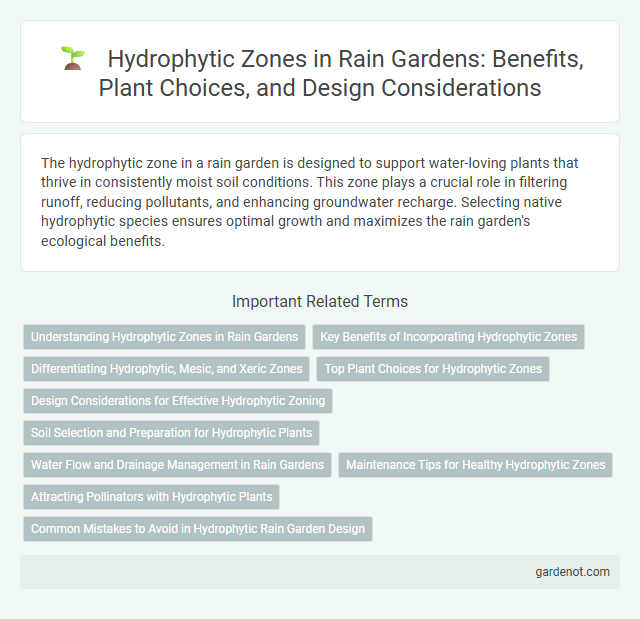The hydrophytic zone in a rain garden is designed to support water-loving plants that thrive in consistently moist soil conditions. This zone plays a crucial role in filtering runoff, reducing pollutants, and enhancing groundwater recharge. Selecting native hydrophytic species ensures optimal growth and maximizes the rain garden's ecological benefits.
Understanding Hydrophytic Zones in Rain Gardens
Hydrophytic zones in rain gardens are specialized areas designed to support moisture-loving plants that thrive in consistently wet conditions. These zones play a crucial role in managing stormwater by filtering pollutants, enhancing water absorption, and preventing runoff. Proper understanding of hydrophytic zones ensures the selection of appropriate native plant species that maximize ecological function and maintain garden health.
Key Benefits of Incorporating Hydrophytic Zones
Hydrophytic zones in rain gardens play a crucial role by supporting water-loving plants that improve stormwater management through enhanced water absorption and pollutant filtration. These zones promote biodiversity by providing habitat for various aquatic species and contribute to groundwater recharge, reducing surface runoff and erosion. Integrating hydrophytic zones maximizes the rain garden's ecological function while maintaining aesthetic appeal.
Differentiating Hydrophytic, Mesic, and Xeric Zones
Hydrophytic zones in rain gardens are characterized by plants adapted to saturated, waterlogged soils, thriving in wet conditions unlike mesic zones that support species requiring moderate moisture and xeric zones dominated by drought-tolerant vegetation. Differentiating these zones relies on soil moisture levels, plant species composition, and root adaptations specific to each environment. Understanding these distinctions optimizes rain garden design for effective stormwater management and biodiversity support.
Top Plant Choices for Hydrophytic Zones
Top plant choices for hydrophytic zones in rain gardens include species like Carex stricta (Tussock Sedge), Pontederia cordata (Pickerelweed), and Lobelia cardinalis (Cardinal Flower), which thrive in saturated soil conditions. These hydrophytic plants provide excellent water filtration, erosion control, and habitat for wetland wildlife. Selecting native perennials with strong root systems enhances the garden's ability to manage stormwater while maintaining ecological balance.
Design Considerations for Effective Hydrophytic Zoning
Effective hydrophytic zoning in rain garden design requires careful analysis of soil moisture gradients and plant water tolerance to ensure proper plant placement. Selecting native hydrophytic species with varying flood and drought resilience enhances water filtration and habitat creation. Proper grading and soil amendments support hydric soil conditions, optimizing water retention and promoting sustainable plant growth within designated wetland zones.
Soil Selection and Preparation for Hydrophytic Plants
Selecting soil for the hydrophytic zone in rain gardens requires a balance between water retention and drainage, favoring loamy or silty soils rich in organic matter to support hydrophytic plants. Proper soil preparation involves amending native soil with compost or sand to improve aeration and nutrient availability while ensuring it remains saturated but not stagnant. Optimizing soil conditions enhances root development and plant health, crucial for effective water filtration and pollutant removal in rain garden ecosystems.
Water Flow and Drainage Management in Rain Gardens
The hydrophytic zone in rain gardens is critical for managing water flow and enhancing drainage by accommodating saturated soil conditions that support water-tolerant plants. This zone facilitates natural filtration and slows runoff, promoting groundwater recharge and reducing erosion risks. Properly designed hydrophytic zones optimize stormwater retention, improving the garden's efficiency in mitigating flooding and pollutant loads.
Maintenance Tips for Healthy Hydrophytic Zones
Maintaining a healthy hydrophytic zone in rain gardens requires regular monitoring of water levels to ensure optimal moisture conditions for native wetland vegetation. Removing invasive species promptly helps preserve biodiversity and prevents competition for resources within the zone. Periodic mulching and gentle pruning promote robust plant growth and enhance the zone's filtration capacity, contributing to improved stormwater management.
Attracting Pollinators with Hydrophytic Plants
Hydrophytic zones in rain gardens feature water-tolerant plants such as pickerelweed, cardinal flower, and blue flag iris that thrive in saturated soils and provide essential nectar and pollen resources. These plants create a vibrant habitat attracting diverse pollinators including bees, butterflies, and hummingbirds, which enhances local biodiversity and supports ecosystem health. Incorporating native hydrophytic species optimizes pollinator activity while improving water filtration and stormwater management.
Common Mistakes to Avoid in Hydrophytic Rain Garden Design
Placing plants outside their preferred hydrophytic zone can lead to poor growth and waterlogging issues in rain gardens. Overestimating soil drainage rates often causes water to pool excessively, harming sensitive hydrophytes. Neglecting to assess seasonal water fluctuations results in plant stress and reduced pollutant filtration efficiency.
Hydrophytic zone Infographic

 gardenot.com
gardenot.com